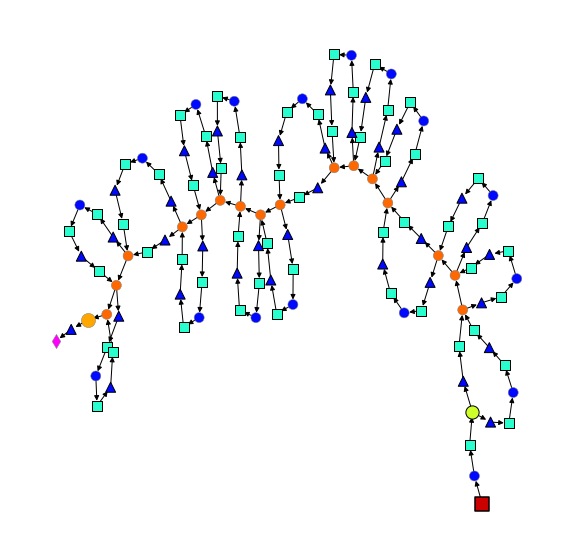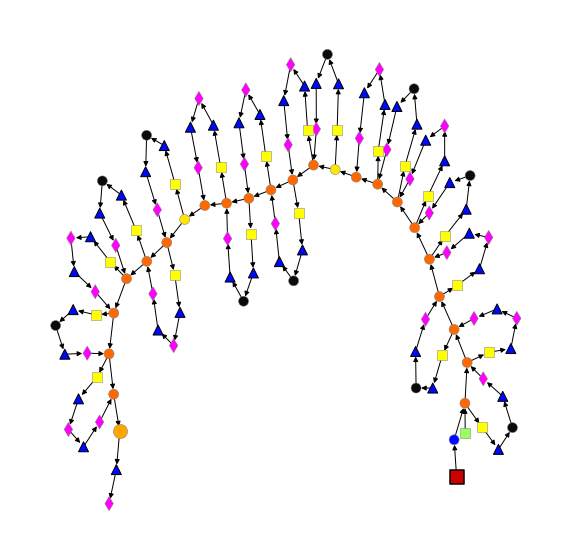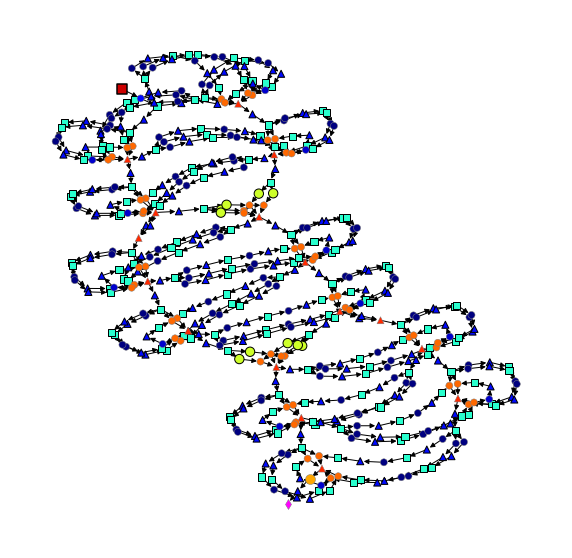authors: Boris Knyazev, Michal Drozdzal, Graham Taylor, Adriana Romero-Soriano
Updates
- [Jun 16, 2023] Code in this repo and in GHN-3 improved, GHN-3 paper to be presented at ICML 2023
- [Mar 22, 2023] Improved Graph HyperNetwork (GHN-3) is now available with a big performance increase: paper, code
- [Jul 21, 2022] Fine-tuning of predicted parameters is improved and parameter prediction for ConvNeXt is added (see report and respective code changes in PR#7)
- [Jul 21, 2022] Training speed of GHNs is further improved (see PR#7 for details)
- [Jan 12, 2022] Training speed of GHNs is improved significantly in some cases (see PR#2 for details)
- [Nov 24, 2021] Video of Yannic Kilcher reviewing our paper together with Boris Knyazev is available on YouTube
| Overview | Results on ResNet-50 |
|---|---|
 |
 |
This repository contains the code to train and evaluate Graph HyperNetworks (GHNs). This repository also contains the DeepNets-1M dataset of neural architectures proposed in our paper to train and evaluate GHNs. Our improved GHNs trained on our DeepNets-1M allow to predict parameters for diverse networks, even if they are very different from those used to train GHNs (e.g. ResNet-50). Parameter prediction by GHNs is performed in a single forward pass and on average takes < 1 second either on GPU or CPU!
We provide a Google Colab notebook to experiment with parameter prediction on the CIFAR-10 dataset. Video walking through the colab notebook and showing parameter prediction in real time.
- Requirements and installation
- Available GHNs
- Minimal example: predict parameters for ResNet-50
- Data
- Reproducing main results
- Visualization
- License
- Contributions
- Acknowledgements
- Citation
The main requirements are:
- Python 3.6+
- PyTorch 1.9+
- NetworkX
For graph visualizations we use pygraphviz. To make it work, graphviz may need to be installed as sudo apt-get install graphviz graphviz-dev.
pip install git+https://github.com/facebookresearch/ppuda
NOTE: It's also possible to install the package in editable mode via
pip install -e .
This step may be needed only if the package installation is failed/skipped.
pip install -r requirements.txt
It's also possible to use conda to install this by running:
conda create --name ppuda --file requirements.txt --channel default --channel anaconda --channel conda-forge --channel pytorch
We release five GHNs. Below are top-1 accuracies on CIFAR-10 and top-5 accuracies on ImageNet using the parameters predicted by one of the GHNs.
| Model | ResNet-50* | Best Architecture (index‡) |
|---|---|---|
| MLP-CIFAR-10 | 17.7 | 60.2 (167) |
| GHN-1-CIFAR-10 | 19.2 | 59.9 (179) |
| GHN-2-CIFAR-10 | 58.6 | 77.1 (210) |
| GHN-1-ImageNet | 6.9 | 32.1 (295) |
| GHN-2-ImageNet | 5.3 | 48.3 (85) |
* ResNet-50 is an unseen architecture (i.e. trained GHNs have not observed such or even similar architectures during training). Our GHNs can still predict good parameters for such unseen architectures. On ImageNet, even though the performance is low, the predicted parameters are very useful for fine-tuning.
‡ Denotes the architecture index in the test split of DeepNets-1M.
Each GHN checkpoint takes just a few megabytes and is stored in the checkpoints folder of this repository. Other checkpoints (ablated GHN models, some networks trained with SGD) are available here.
ImageNet:
from ppuda.ghn.nn import GHN2
import torchvision.models as models
ghn = GHN2('imagenet') # load our GHN-2 trained on ImageNet
model = models.resnet50() # ResNet-50 or any other torchvision model
model = ghn(model) # predict parameters in < 1 second on GPU/CPU
# That's it! The model can be now evaluated on ImageNet to obtain top5=5.2%.
CIFAR-10:
from ppuda.ghn.nn import GHN2
import torchvision.models as models
# On CIFAR-10, we have an additional step of adjusting
# the first layer(s) of the network for a 32x32 image size,
# since torchvision models expect a 224x224 input,
# while GHNs on CIFAR-10 were trained on 32x32 inputs.
from ppuda.utils import adjust_net
ghn = GHN2('cifar10') # load our GHN-2 trained on CIFAR-10
model = models.resnet50(num_classes=10) # ResNet-50
model = adjust_net(model) # adjust to a 32x32 input
model = ghn(model) # predict parameters in < 1 second on GPU/CPU
# That's it! The model can be now evaluated on CIFAR-10 to obtain top1=58.6%.
Full example for ResNet-50 and other torchvision models can be found in examples/torch_models.py and examples/all_torch_models.py. See other examples in examples.
Note 1: For the networks with batch norm, the running statistics of batch norm layers are not predicted (since these statistics are not trainable parameters). So to evaluate such networks, our code computes batch statistics on the evaluation set with batch size = 64. The networks without batch norm (e.g. in our BN-Free split) have the same accuracies regardless of the batch size.
Note 2: To evaluate/train on ImageNet, follow the data instructions below on how to prepare the ImageNet dataset.
To train or evaluate on DeepNets-1M, first download the dataset file by running ./data/download.sh.
To generate a new DeepNets-1M dataset, the following command can be used:
python experiments/net_generator.py train 1000000 ./data
The dataset generated using this command should be close to our training dataset. Other splits can be regenerated by specifying the split as the first argument.
CIFAR-10 is downloaded automatically and is saved in the --data_dir folder (default is ./data).
We implemented a simple wrapper of the torchvision.datasets.ImageNet implementation. The ImageNet root folder imagenet is expected to be in the ./data folder by default with the following structure:
./data
│ imagenet
│ │ train
| | | n01440764
| | | n01443537
| | | ...
│ │ val
| | | n01440764
| | | n01443537
| | | ...
│ │ ILSVRC2012_devkit_t12.tar.gz
│ deepnets1m_train.hdf5
| deepnets1m_train_meta.json
| ...
Both imagenet/train and imagenet/val must contain separate folders for each class. Follow the official instructions on how to obtain ImageNet (ILSVRC 2012) data.
The arguments of our scripts are described in config.py. The default hyperparameters are based on our paper. Below, the examples to run the scripts and override the default hyperparameters are shown.
-
GHN-1 on CIFAR-10:
python experiments/train_ghn.py --name ghn1 -
GHN-2 on CIFAR-10:
python experiments/train_ghn.py -m 8 -n -v 50 --ln --name ghn2 -
MLP on CIFAR-10:
python experiments/train_ghn.py -m 8 -n -v 50 --ln -H mlp --name mlp
where -m 8 denotes meta batch size = 8, -n denotes to normalize predicted parameters, -v 50 denotes adding virtual edges to graphs with 50 as the maximum shortest path length, --ln denotes adding layer normalization before decoding the parameters, --name ghn2 denotes the directory name where to save trained checkpoints (which is combined with --save_dir to obtain the full path), -H mlp denotes using MLP instead of GatedGNN.
To train on Imagenet, use -d imagenet.
To train GHNs on multiple GPUs (e.g. with a large meta batch size), add --multigpu to use all CUDA devices available (make sure to set CUDA_VISIBLE_DEVICES appropriately).
For example, to train GHN-2 on Imagenet and 4 GPUs: export CUDA_VISIBLE_DEVICES=0,1,2,3; python experiments/train_ghn.py -m 8 -n -v 50 --ln --name ghn2_imagenet -d imagenet --multigpu
-
Evaluate GHN-2 on CIFAR-10 on all architectures of
$splitfrom DeepNets-1M:python experiments/eval_ghn.py --ckpt ./checkpoints/ghn2_cifar10.pt -d cifar10 --split $split -
Evaluate GHN-2 on CIFAR-10 on a single architecture from DeepNets-1M:
python experiments/eval_ghn.py --ckpt ./checkpoints/ghn2_cifar10.pt -d cifar10 --split $split --arch $ind
where $split is one from val, test, wide, deep, dense, bnfree, predefined, $ind is an integer index of the architecture in a split.
-
Train architecture=0 from the
testsplit of DeepNets-1M for 50 epochs on CIFAR-10:python experiments/sgd/train_net.py --split test --arch 0 --epochs 50 -
Train the best architecture from the DARTS paper for 50 epochs on CIFAR-10:
python experiments/sgd/train_net.py --arch DARTS --epochs 50 -
Train architecture=0 from the
widesplit of DeepNets-1M for 1 epoch on ImageNet:python experiments/sgd/train_net.py --split wide --arch 0 --epochs 1 -d imagenet
The parameters predicted by GHN-2 trained on ImageNet can be fine-tuned on any vision dataset, such as CIFAR-10.
[Update Jul 21, 2022]
According to the report (Pretraining a Neural Network before Knowing Its Architecture) showing improved fine-tuning results, the following arguments are added to the code: --opt, --init, --imsize, --beta, --layer.
-
For example, to obtain fine-tuning results of
GHN-orthfor ResNet-50:python experiments/sgd/train_net.py --val --split predefined --arch 0 --epochs 300 -d cifar10 --n_shots 100 --lr 0.01 --wd 0.01 --ckpt ./checkpoints/ghn2_imagenet.pt --opt sgd --init orth --imsize 32 --beta 3e-5 --layer 37 -
For ConvNeXt-Base:
python experiments/sgd/train_net.py --val --arch convnext_base -b 48 --epochs 300 -d cifar10 --n_shots 100 --lr 0.001 --wd 0.1 --ckpt ./checkpoints/ghn2_imagenet.pt --opt adamw --init orth --imsize 32 --beta 3e-5 --layer 94. Multiple warnings will be printed that some layers of ConvNeXt are not supported by GHNs, which is intended. Note that in the report, layer 100 is mistakenly specified as the best value, however 94 should be used for better performance.
Below are the commands to reproduce the original (NeurIPS 2021) results.
-
Fine-tune ResNet-50 initialized with the parameters predicted by GHN-1-ImageNet:
python experiments/sgd/train_net.py --split predefined --arch 0 --epochs 50 -d cifar10 --n_shots 100 --wd 1e-3 --ckpt ./checkpoints/ghn1_imagenet.pt -
Fine-tune ResNet-50 initialized with the parameters predicted by GHN-2-ImageNet:
python experiments/sgd/train_net.py --split predefined --arch 0 --epochs 50 -d cifar10 --n_shots 100 --wd 1e-3 --ckpt ./checkpoints/ghn2_imagenet.pt -
Fine-tune ResNet-50 initialized randomly with Kaiming He's method:
python experiments/sgd/train_net.py --split predefined --arch 0 --epochs 50 -d cifar10 --n_shots 100 --wd 1e-3 -
Fine-tune ResNet-50 pretrained on Imagenet:
python experiments/sgd/train_net.py --split predefined --arch 0 --epochs 50 -d cifar10 --n_shots 100 --wd 1e-3 --pretrained -
Fine-tune ViT initialized with the parameters predicted by GHN-2-ImageNet:
python experiments/sgd/train_net.py --split predefined --arch 1 --epochs 50 -d cifar10 --n_shots 100 --wd 1e-3 --ckpt ./checkpoints/ghn2_imagenet.pt -
Fine-tune DARTS initialized with the parameters predicted by GHN-2-ImageNet:
python experiments/sgd/train_net.py --arch DARTS --epochs 50 -d cifar10 --n_shots 100 --wd 1e-3 --init_channels 48 --layers 14 --ckpt ./checkpoints/ghn2_imagenet.pt
--wd 1e-3 was generally the best in these experiments. To report the results in the paper, we also tuned the initial learning rate on the 200 validation images of the 100-shot CIFAR-10 training set, so the results obtained with the scripts above might be a bit different from the reported ones.
In the paper, we fine-tune on Penn-Fudan object detection. Our experiments are based on PyTorch Object Detection Finetuning Tutorial.
The dataset can be downloaded from here and should be put inside the ./data folder like ./data/PennFudanPed.
The commands to fine-tune/train networks for object detection are similar to those for 100-shot CIFAR-10 above, but are based on the experiments/sgd/detector/train_detector.py script and the hyperparameters from the tutorial. For example, to fine-tune DARTS initialized with the parameters predicted by GHN-2-ImageNet.
python experiments/sgd/detector/train_detector.py -d PennFudanPed --arch DARTS --ckpt ./checkpoints/ghn2_imagenet.pt --init_channels 48 --layers 14
To train and evaluate regression models on top of graph embeddings extracted using GHN-2-CIFAR-10:
python experiments/property_prediction.py cifar10 ./checkpoints/ghn2_cifar10.pt
The script will evaluate the four properties of architectures discussed in the paper: accuracy on the clean test set, accuracy on a corrupted test set, inference speed, and speed of convergence.
The extracted embeddings in the .npy format for each GHN are available in the checkpoints folder, but will be recomputed if they are missing.
Training the best (in terms of accuracy in this example) architecture on CIFAR-10 with SGD for 600 epochs according to the DARTS protocol:
python experiments/sgd/train_net.py --split search --arch 35133 --epochs 600 --cutout --drop_path_prob 0.2 --auxiliary
Architecture 35133 was found to be the best in the search split on CIFAR-10 using our GHN-2.
Example of visualizing the computational graph of ResNet-50.
import torchvision
from ppuda.deepnets1m.graph import Graph
Graph(torchvision.models.resnet50()).visualize(node_size=100)
Example of visualizing the computational graph of the best DARTS network.
from ppuda.deepnets1m.graph import Graph
from ppuda.deepnets1m.net import Network
from ppuda.deepnets1m.genotypes import DARTS
model = Network(C=48, num_classes=1000, genotype=DARTS, n_cells=14)
Graph(model).visualize(node_size=50)
| ResNet-50 | ViT | DARTS |
|---|---|---|
 |
 |
 |
See more examples for different architectures in examples/graph_visualization.ipynb.
The majority of PPUDA is licensed under MIT license, however portions of the project are available under separate license terms: DARTS is licensed under the Apache 2.0 license and NetworkX is licensed under the 3-Clause BSD license.
Please submit a pull request or open a github issue (see the details). Make sure to comply with our code of conduct.
We thank the Vector AI Engineering team (Gerald Shen, Maria Koshkina and Deval Pandya) for code review.
@inproceedings{knyazev2021parameter,
title={Parameter Prediction for Unseen Deep Architectures},
author={Knyazev, Boris and Drozdzal, Michal and Taylor, Graham W and Romero-Soriano, Adriana},
booktitle={Advances in Neural Information Processing Systems},
year={2021}
}
